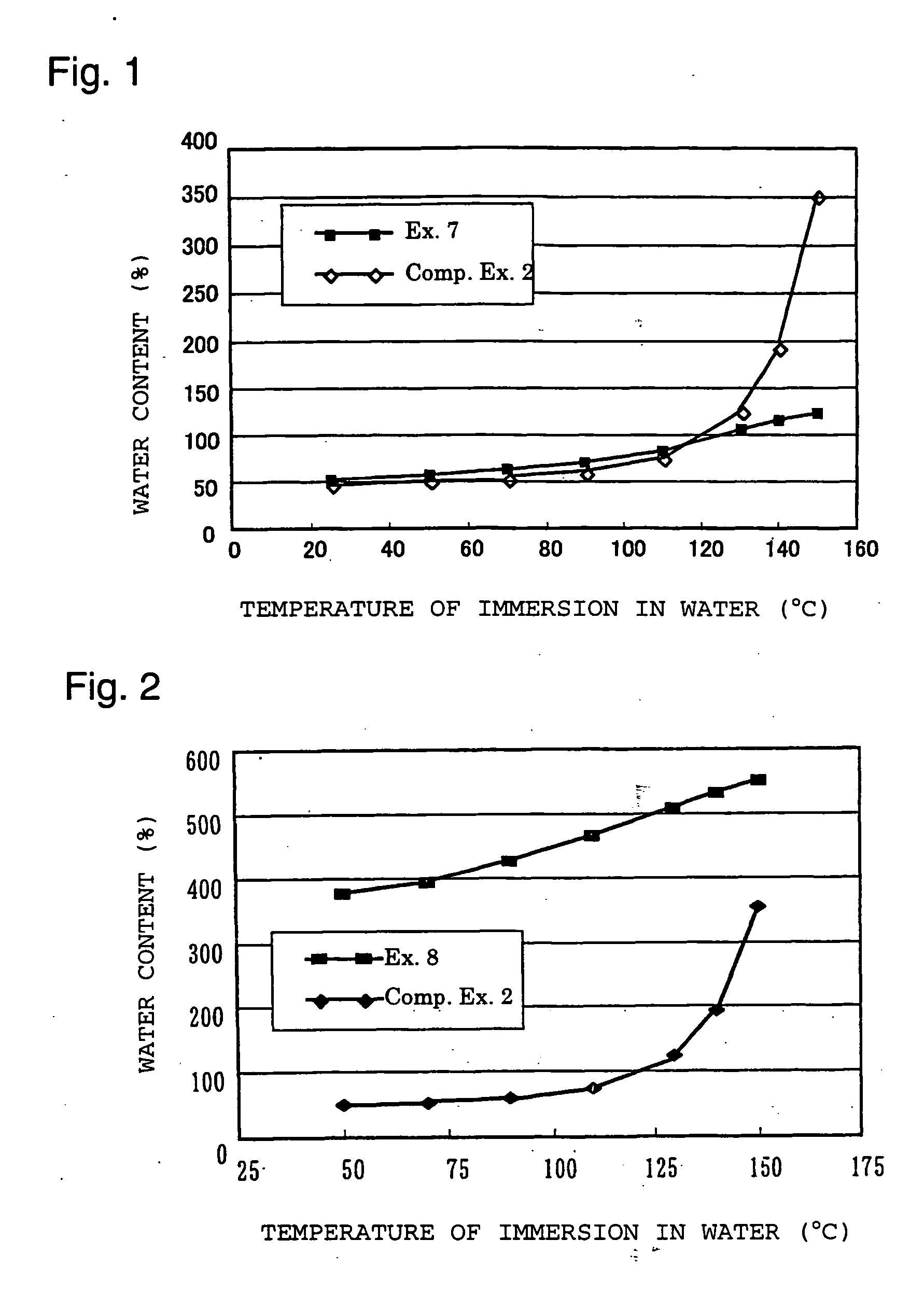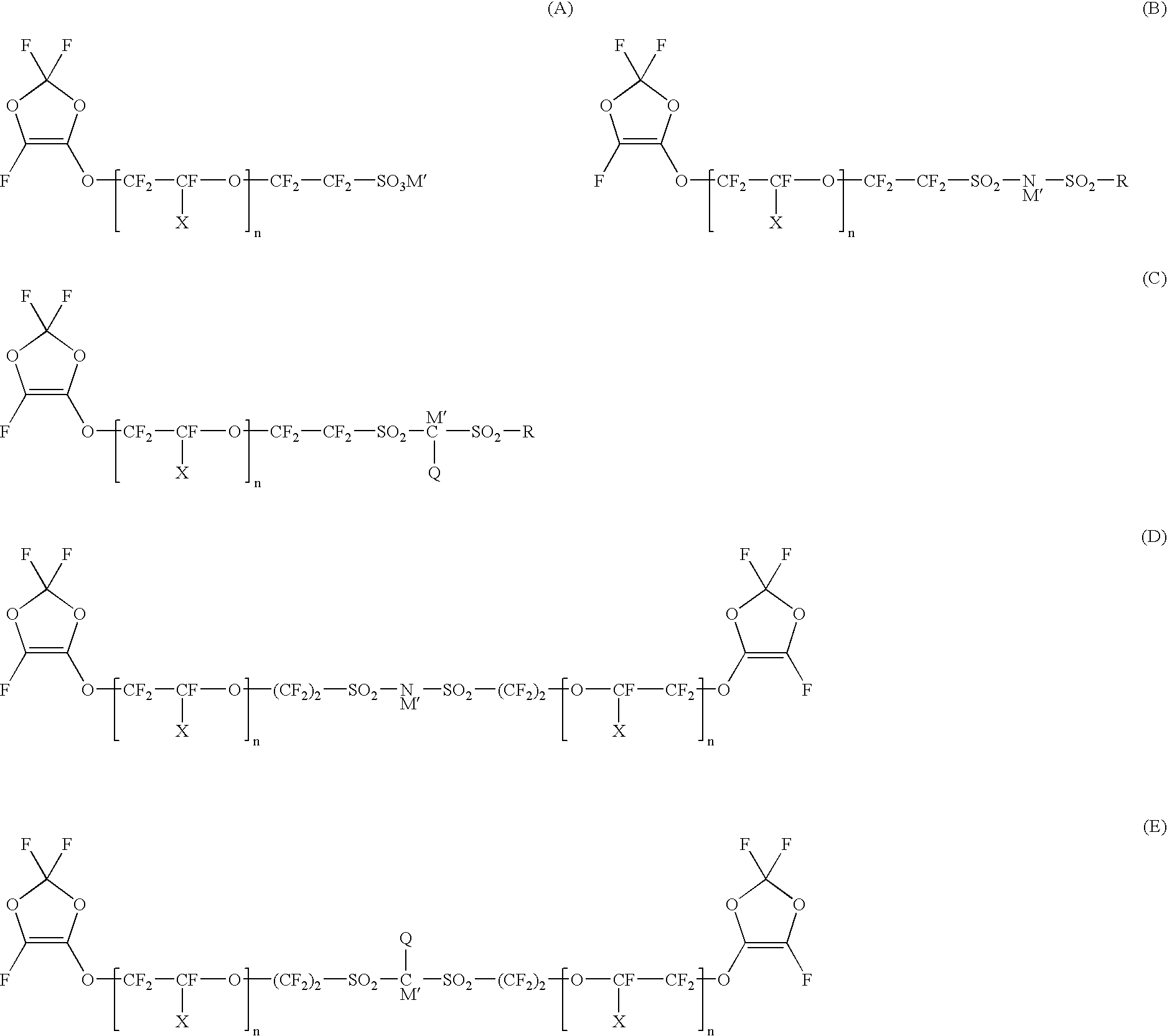Polymer electrolyte material, production method thereof and membrane electrode assembly for polymer electrolyte fuel cell
a technology of electrolyte fuel cell and polymer electrolyte, which is applied in the direction of non-aqueous electrolyte cells, sustainable manufacturing/processing, non-metal conductors, etc., can solve the problems of not being produced in practice, reducing the output power of the fuel cell, and too low softening temperature to meet these demands. , to achieve the effect of increasing the output of the fuel cell
- Summary
- Abstract
- Description
- Claims
- Application Information
AI Technical Summary
Benefits of technology
Problems solved by technology
Method used
Image
Examples
example 1
[0117] A homopolymer of the compound (4) was obtained as follows.
[0118] The compound (4) (1.25 g) and perfluorobenzoyl peroxide (4.5 mg) were put into a glass tube, solidified with liquid nitrogen, and sealed in vacuum. The mixture was maintained at 70° C. for 45 hours and a polymer produced was taken out, dissolved in n-C6F13H, reprecipitated with hexane, washed with hexane after filtration, and dried under reduced pressure at 80° C. for 16 hours. The yield of the homopolymer of the compound (4) was 0.823 g (yield 66%). The Mn measured by means of GPC was 6.5×104, and the Mw was 9.8×104. The glass transition temperature measured by DSC was 92° C. The refractive index was 1.35.
[0119] Furthermore, the filtrate was concentrated under reduced pressure, then precipitated and washed, and a low boiling component was distilled off under reduced pressure. Then the resultant was dried under reduced pressure at 80° C. for 16 hours, to recover a polymer in the form of powder (0.072 g) compos...
example 2
[0122] The compound (4) and perfluoro(2-methylene-4-methyl-1,3-dioxolane) were copolymerized, followed by hydrolysis and conversion into an acid form, as described below.
[0123] 7.90 g of the compound (4), 9.60 g of perfluoro(2-methylene-4-methyl-1,3-dioxolane), 109.7 g of HCFC 225 cb and 255 mg of perfluorobenzoyl peroxide were charged into a stainless steel autoclave having a capacity of 0.1 L, and cooled with liquid nitrogen, followed by deaeration. After reaction at 70° C. for 5 hours, the resultant mixture was poured into hexane so as to precipitate a polymer. After washing with hexane, the precipitate was dried in vacuum at 100° C. to obtain 14.0 g of a white polymer.
[0124] The ion-exchange capacity AR of the above-mentioned polymer was determined to be 1.13 meq / g, based on the content of sulfur obtained by the elemental analysis. The intrinsic viscosity at 30° C. measured using perfluoro(2-butyltetrahydrofuran) as a solvent was 0.16 dl / g.
[0125] 40 g of methanol and 160 g of...
example 3
[0127] The compound (4) and perfluoro(2-methylene-4-methyl-1,3-dioxolane) were copolymerized, followed by hydrolysis and conversion into an acid form, as described below. 4.36 g of the compound (4), 7.31 g of perfluoro(2-methylene-4-methyl-1,3-dioxolane), 72.59 g of HCFC 225 cb and 170 mg of perfluorobenzoyl peroxide were charged into a stainless steel autoclave having a capacity of 0.1 L, and cooled with liquid nitrogen, followed by deaeration. After reaction at 70° C. for 5 hours, polymer coagulation, washing and drying were conducted in the same manner as in Example 2 to obtain 9.35 g of a white polymer.
[0128] The ion-exchange capacity AR of the above-mentioned polymer was determined to be 0.97 meq / g, based on the content of sulfur obtained by the elemental analysis. The intrinsic viscosity at 30° C. measured using perfluoro(2-butyltetrahydrofuran) as a solvent was 0.16 dl / g.
[0129] This polymer was hydrolyzed and converted into an acid form in the same manner as in Example 2 to...
PUM
| Property | Measurement | Unit |
|---|---|---|
| Temperature | aaaaa | aaaaa |
| Electric potential / voltage | aaaaa | aaaaa |
| Electric potential / voltage | aaaaa | aaaaa |
Abstract
Description
Claims
Application Information
 Login to View More
Login to View More - R&D
- Intellectual Property
- Life Sciences
- Materials
- Tech Scout
- Unparalleled Data Quality
- Higher Quality Content
- 60% Fewer Hallucinations
Browse by: Latest US Patents, China's latest patents, Technical Efficacy Thesaurus, Application Domain, Technology Topic, Popular Technical Reports.
© 2025 PatSnap. All rights reserved.Legal|Privacy policy|Modern Slavery Act Transparency Statement|Sitemap|About US| Contact US: help@patsnap.com



